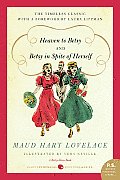 My daughter, Catherine, and I went to our mother-daughter book club meeting on Monday. We were set to discuss Heavens to Betsy, one of the Betsy-Tacy series by Maud Hart Lovelace.
My daughter, Catherine, and I went to our mother-daughter book club meeting on Monday. We were set to discuss Heavens to Betsy, one of the Betsy-Tacy series by Maud Hart Lovelace.
The book begins with the news that Betsy’s family is moving away from her beloved home on Hill St. to a larger place on High St. Betsy will be far away from her best friend Tacy, and at first she’s not happy about being in a new neighborhood. But as she starts school and makes new friends while still being able to see Tacy regularly, Betsy begins to like her new life.
Two local boys walk Betsy to school every day, but they joke around a lot and she doesn’t consider either one to be a boyfriend. When a tall, dark stranger arrives at her school and becomes part of their crowd of friends, Betsy is taken with him and wonders if he is interested in her as well.
Even though the series starts much earlier, this was the first book we read as a group. The girls chose it because it’s about Betsy’s first year in high school, and as sophomores, they well remember what it’s like to be freshman.
Discussion was good. The girls noted the differences between high school and social life in the early 1900s and today. One of the girls said she thought it was a perfect book to read when you want to de-stress from a hectic schedule. It’s light reading, with little conflict. On the other hand, some of the girls had a hard time relating with Betsy’s perfect life. She got along well with her sisters and her parents, she had lots of friends, and homework didn’t take up much of her time. They believed the book would have been more interesting if there were a few more worries thrown Betsy’s way.
I think we would have liked it better if this wasn’t the first book in the series that we read. If the girls had begun reading about Betsy when they were younger, and if they had followed her story from when it started, I believe we would have had more to talk about.
All in all Heavens to Betsy was interesting for the glimpse it provided of what seemed to be upper-middle-class social life for teens in the early 1900s.

